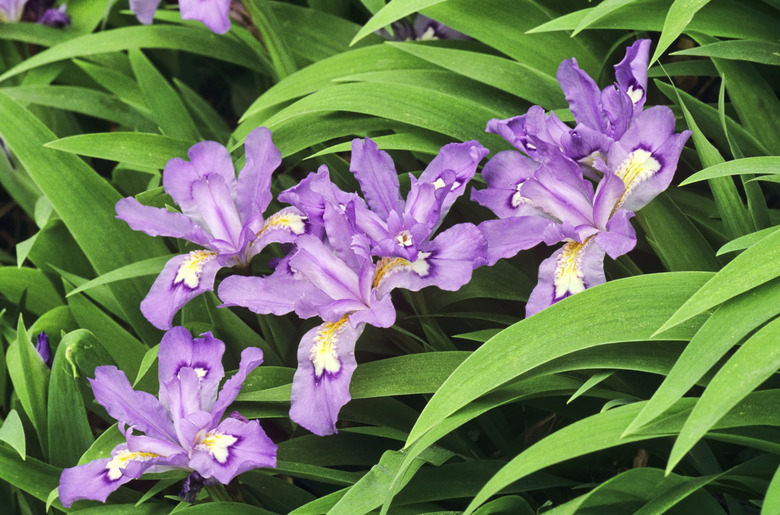The Tennessee State Bird, Tree And Flower
Each state in the United States designates a bird, tree and flower that represent the region's identity. State symbols help to highlight and distinguish the unique natural heritage of each of the 50 United States. The Tennessee state birds, trees and flowers are some of the state's many cultural and natural symbols. The Tennessee State Government provides a complete list of the state's symbols, along with information about each symbol.
Tennessee State Birds
Tennessee State Birds
Tennessee has two state birds. The first, the Northern Mockingbird (Mimus polyglottos), was designated in 1933. With a characteristic song and the ability to mimic other songbirds and sounds, the mockingbird has a wide range in the United States. Mentioned in many songs, books and TV shows, the University of Texas at Austin notes that the mockingbird is also the state bird in four other states in the southern United States: Arkansas, Texas, Florida and Mississippi.
Northern Mockingbirds are mostly grey with white underparts and wing edges, and they measure about ten inches long. Mockingbirds are noted for their intelligence, and they can mimic the songs of about 50 other birds. They also mimic non-bird sounds, like dogs and other animals. According to the Cornell Lab of Ornithology, mockingbirds often sing all day and into the night.
The second Tennessee state bird is its official game bird, the Northern Bobwhite Quail (Colinus virginianus). Designated in 1987, the bobwhite is also known as the partridge. The Northern Bobwhite is a small bird with brown and white feathers that help it blend in with grasslands. The bobwhite population has been in decline over the past 50 years due to habitat loss, notes the Cornell Lab of Ornithology.
Tennessee State Trees
Tennessee State Trees
Tennessee has two state trees – one deciduous and one evergreen. Its first state tree, the tulip poplar (Liriodendron tulipifera), was designated in 1947. It's important to Tennessee because of its wide range and extensive use in building construction. The tulip poplar is also the state tree of Kentucky and Indiana.
A fast-growing tree, the tulip poplar often reaches heights of 150 feet in the forest, notes the University of Kentucky. The tulip poplar is native to the United States and valued for its straight trunk, which produces uniform logs for construction purposes. Native Americans used tulip poplars to make dugout canoes, and the wood from the tree is used today to make plywood, furniture, flooring and paper pulp.
The eastern red cedar (Juniperus virginiana) is Tennessee's state evergreen tree. Made official in 2012, the tree is native to the entire state. Eastern red cedar has scale-like leaves and produces small, bluish fruits, according to the University of Tennessee. It's a small- to medium-sized evergreen and is planted frequently as a landscape tree. Eastern red cedar is sacred to the Cherokee peoples and is essential to Tennessee's cedar glades ecosystems.
Tennessee State Flowers
Tennessee State Flowers
Tennessee has more than one official state flower – one cultivated flower and two wildflowers. Its cultivated flower is the iris (family Iridaceae, genus Iris; note that some sites claim the family name is the genus name as well). Although the state did not designate a particular color of iris, purple is commonly accepted as the official state hue, according to the University of Tennessee. Irises come in a wide range of colors, and they generally flower in Tennessee in April and May.
One of Tennessee's state wildflowers is the passion flower (Passiflora sp.). Also known as the maypop, the wild apricot and the ocoee, the passion flower grows wild in Tennessee and the southern United States. With an exotic-looking lavender or purple bloom, this species attracts butterflies and other pollinators.
Found only in specific places in Tennessee, the Tennessee coneflower (Echinacea tennesseensis) is the state's other official wildflower. The Tennessee coneflower was discovered in the cedar glades of the Central Basin of Tennessee in 1878, notes the University of Tennessee, and has a limited native range. One of the first plants to be listed as endangered in the United States in 1979, the species has recovered due to the conservation of its unique habitat in Tennessee.
References
- Tennessee State Government: State Symbols
- The University of Texas at Austin: Campus Biodiversity: Northern Mockingbirds
- The Cornell Lab of Ornithology: Northern Mockingbird
- The Cornell Lab of Ornithology: Northern Bobwhite
- University of Kentucky: Tulip Poplar
- University of Tennessee: Eastern Red Cedar/Old Field Juniper (Juniperus Virginiana)
Cite This Article
MLA
Sloane, Christina. "The Tennessee State Bird, Tree And Flower" sciencing.com, https://www.sciencing.com/tennessee-state-bird-tree-flower-6729006/. 30 September 2021.
APA
Sloane, Christina. (2021, September 30). The Tennessee State Bird, Tree And Flower. sciencing.com. Retrieved from https://www.sciencing.com/tennessee-state-bird-tree-flower-6729006/
Chicago
Sloane, Christina. The Tennessee State Bird, Tree And Flower last modified March 24, 2022. https://www.sciencing.com/tennessee-state-bird-tree-flower-6729006/
